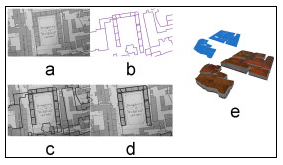The first step in virtualizing a building is tracing it. That’s a tough and time-consuming activity. It can be creative but it can also produce inaccuracies. Now scientists at the University of East Anglia have developed a software that can capture and restore destroyed buildings from old maps.

Professor Stephen Laycock and his team have created a tool that will automatically extract dimensions and relationships from colored maps. Users can extract black and white maps by directing a cursor within the building’s mapped edges.
Laycock, who is a specialist in “the application of new graphics techniques to Cultural Heritage” works with East Anglia’s Computer Graphics Group on projects that use data visualization to increase awareness and add perspective to historical and archaeological investigations.
As Jacob Aron points out, in New Scientist, this software can help not just visualize what’s extant in a changed context but “make it easier to create digital reconstructions of long-lost cities.” Neglect, change in economic lifelines like trade routes and natural disasters have all contributed, and continue to contribute, to the death of once-important cities. Being able to visualize how cities worked over the ages could help us understand how our own work, or fail to work, today.

Laycock’s software increases the efficiency of extracting information from maps by at least 100 percent on black and white maps and makes the process as much as 100 times faster on colored maps or colored elements of maps, where the software’s automatic function engages.
From the abstract of Laycock’s paper on the creation of the software:*
“Archive cartography and archaeologist’s sketches are invaluable resources when analysing a historic town or city. A virtual reconstruction of a city provides the user with the ability to navigate and explore an environment which no longer exists to obtain better insight into its design and purpose. However, the process of reconstructing the city from maps depicting features such as building footprints and roads can be labour intensive…Archive maps often exhibit problems in the form of inaccuracies and inconsistencies in scale which can lead to incorrect reconstructions. By aligning archive maps to accurate modern vector data one may reduce these problems.”
The applications of this software are legion. Creating 3D virtualizations of cities that are changed beyond understanding or even destroyed altogether could help in educational endeavors, museum materials, historical work, public policy, even gaming. And it can be shared online, meaning a further democratization of the past.
Also, as I feel compelled to point out yet again: it’s awfully cool.
*Yes, abstract. Do you have any idea how much academic publications cost, despite the advances of the Open Access movement? Plenty, that’s how much.

















